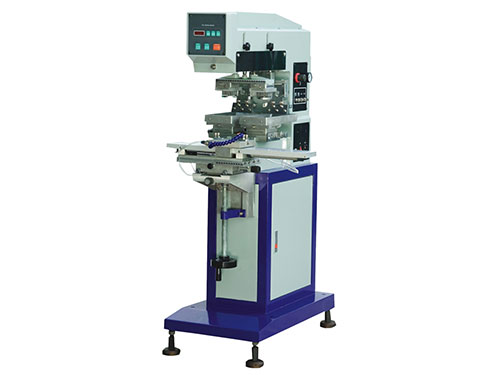Pad printer overview, working principle, application and usage
How Pad Printers Work
The 7 major operation steps of the pad printing machine will make you a pad printing master!
1. Start the power supply: Start the power switch of the pad printing machine, and carefully check whether the machine plug is loose.
2. Add appropriate amount of ink: After the power is turned on, add an appropriate amount of ink to the oil pan steel plate, and then dilute the ink with a thinner, which can be operated by pressing the front and rear keys.
3. The scraper scrapes off the ink: the scraper scrapes off the excess ink on the steel plate, leaving only the ink on the etched surface.
4. Adhesive ink on the rubber head: the glue located directly above the steel plate will press down, and the ink will immediately stick to the surface of the rubber head.
5. Pattern transfer: The ink-stained rubber head will rise vertically, then move horizontally to the top of the product, and land tightly to transfer the pattern on the product.
6. Remove the glue head: After the pattern is printed, the glue head will rise slowly and return to its original shape. Waiting for the next printing.
7. Turn off the power supply: after printing or when you need to take a rest, turn off the power supply to reduce the cost loss and the probability of accidents.
How to use the pad printing machine, the correct operation method of the pad printing machine for pad printing
1. Before starting the pad printing machine, check whether the air pressure of the connecting rod is normal, whether there is any collision or abnormality in each moving part of the manual operation, and whether the lubricating parts are lubricated regularly.
2. The positioning jig must be firmly fixed and positioned accurately to avoid mistakes in the pad printing process.
3. Before batch printing, the first sample must be confirmed by the printing supervisor, and then the quality, position, and color must be confirmed.
4. If abnormal sounds and other abnormal phenomena are found. Immediately stop the machine and report it to superiors.
5. The pad printing processing area must be kept clean. Tools, measuring tools, positioning fixtures, pad printing oil, rags, gloves, pad printing heads, etc. should be placed in the specified places.
What is a pad printer?
A pad printer is a kind of printing equipment, suitable for plastic, toys, glass, metal, ceramics, electronics, IC packaging, etc. Pad printing is an indirect intaglio printing technology, which has become the main method for surface printing and decoration of various objects.
Application range of pad printing machine
Pad printers are widely used in daily necessities, toys, pens, electronics, electrical appliances, plastics, leather, metal, glass, light industry, food packaging, and other industries.
Buttons of various electronic products, mobile phone keyboards, electronic panels, telephones, game consoles, and hardware and plastic objects such as clocks, toys, daily necessities, gifts, etc. LOGO, pattern printing, and special models can also be designed for special product needs.
How to make a pad printing machine
Pad printing is an indirect intaglio head printing technology, which usually refers to the irregularly shaped surface of the substrate (such as instruments, electrical parts, toys, etc.), using copper or steel intaglio, cast into a hemispherical surface through silicone rubber Shaped pad printing head, which presses against the plate to transfer the ink to the substrate to complete the transfer printing. Because it can print text, graphics, and images on the surface of irregularly shaped objects, it has become the main method for printing and decorating the surfaces of various objects.
Expand knowledge
The production method of pad printing plate:
1. Clean the blank steel plate (boil oily water to clean up the oil stains on it, and clean tap water is also applicable).
2. Pad printing photosensitive paste sizing, sizing requires dust-free, natural drying or high-temperature drying for the next step of production.
3. For film output, prepare the film before production.
4. The exposure machine sticks the film on the surface of the pad printing steel plate with good paste and reversely presses it on the top of the exposure machine to perform the post-exposure treatment.
5. After exposure, use developing water to wash away the part of the graphics covered by the film but not exposed.
6. The last step is to use etching water to etch the steel plate of the graphic part, and finally clean the photosensitive paste of the photosensitive part with boiling oil water.
 English
English 中文
中文




